Elderly Abuse: A Discussion of Factors and Nursing Interventions
VerifiedAdded on 2022/11/25
|10
|1770
|364
Essay
AI Summary
This essay delves into the pressing issue of elderly abuse, particularly within the Australian context. It begins by outlining the prevalence of elderly abuse, highlighting the increasing number of cases and the vulnerability of the aging population, especially those with cognitive impairments. The essay explores various risk factors, including divorce, death of a partner, ill-health, social isolation, and financial dependency. It emphasizes the importance of nursing care, detailing how nurses can identify abuse, ensure privacy, and adhere to relevant legislation, such as the Aged Care Act 1987. Furthermore, the essay discusses how technological advancements and policy changes, such as the introduction of phone line support and national action plans, can impact the care process. It also references studies on the prevalence of different types of abuse, like psychological and financial abuse, and suggests that awareness programs and public education strategies are essential to address this issue. The essay concludes by emphasizing the role of government in implementing action plans, awareness programs, and utilizing technology to support the elderly population.
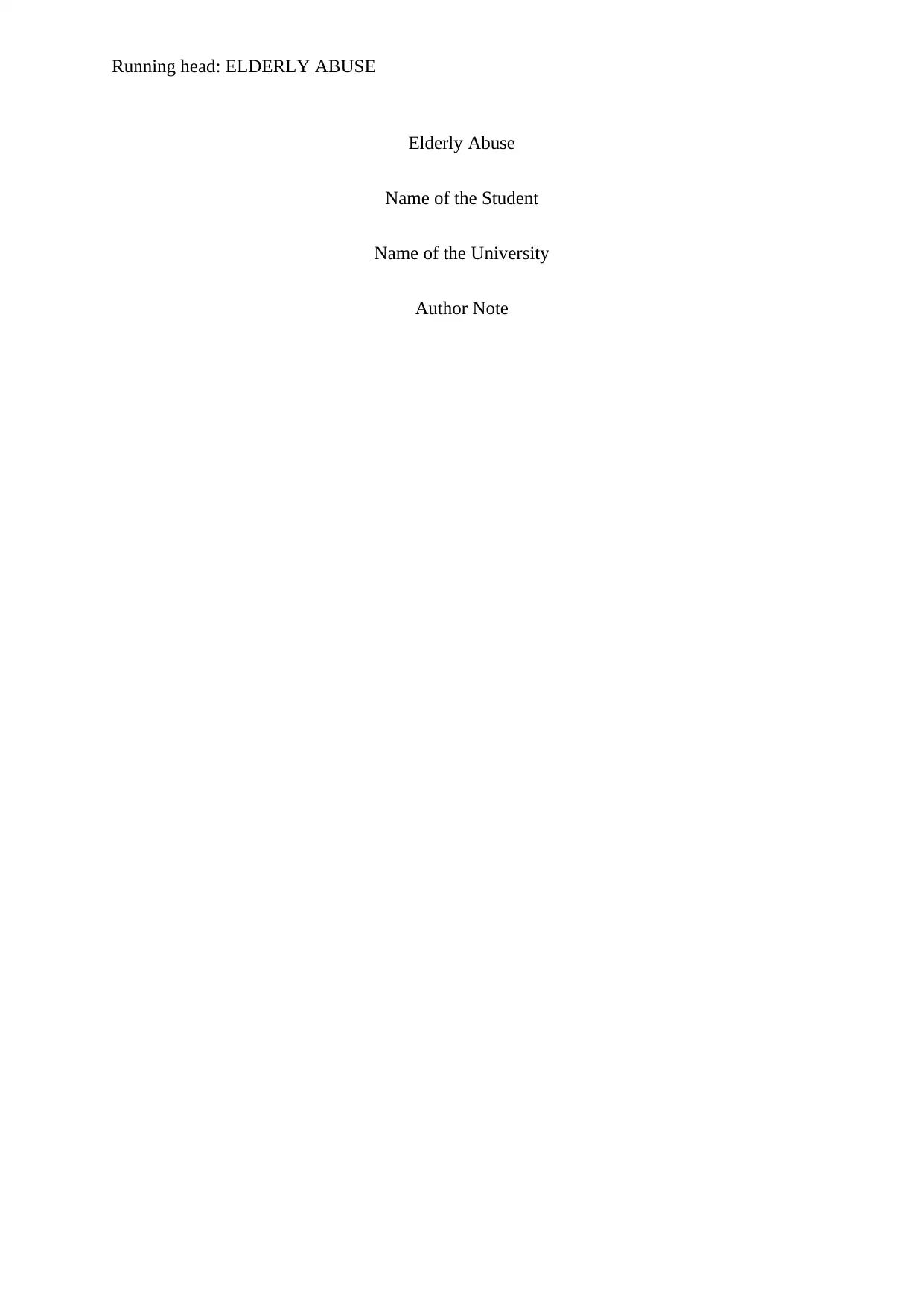
Running head: ELDERLY ABUSE
Elderly Abuse
Name of the Student
Name of the University
Author Note
Elderly Abuse
Name of the Student
Name of the University
Author Note
Paraphrase This Document
Need a fresh take? Get an instant paraphrase of this document with our AI Paraphraser
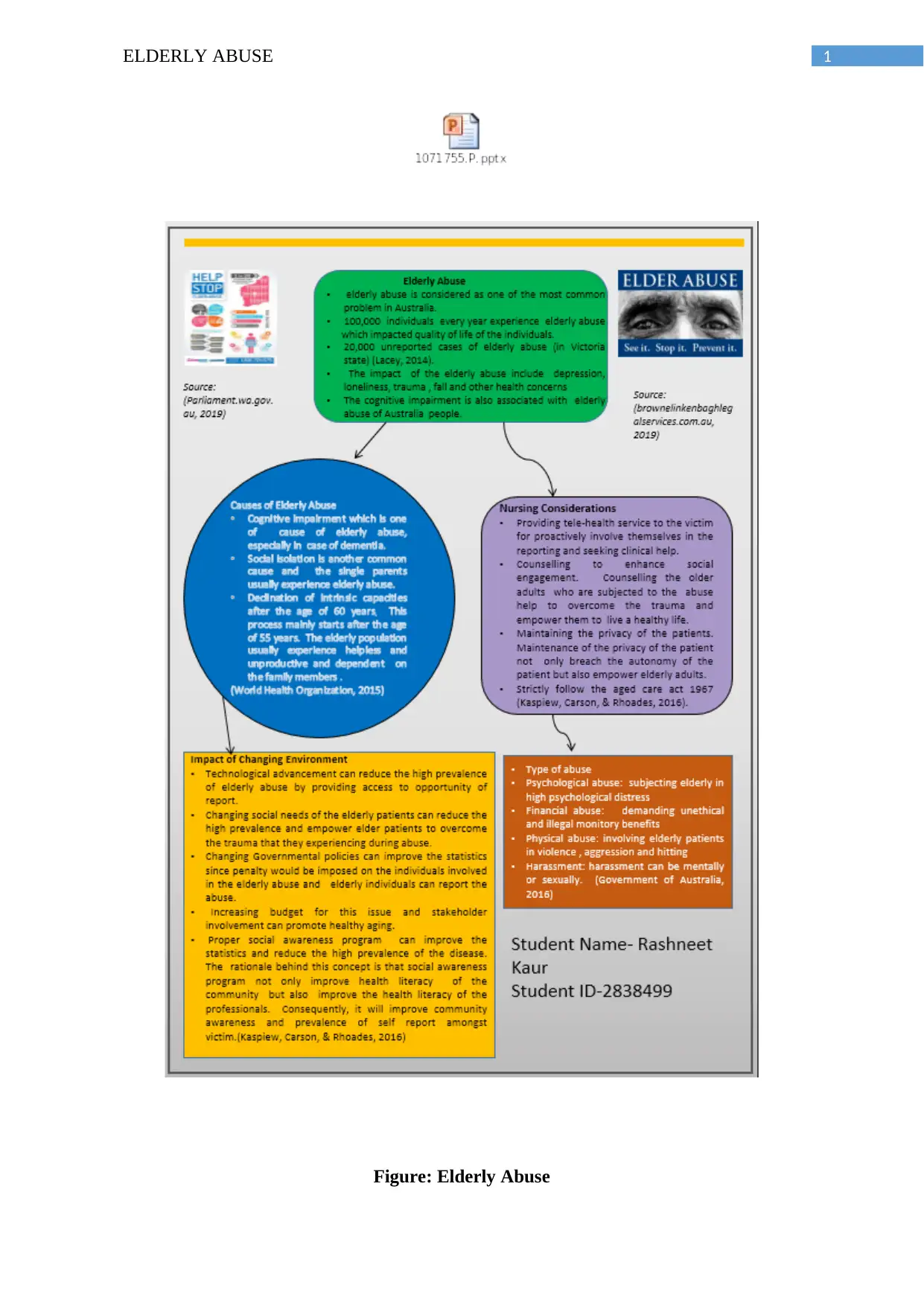
1ELDERLY ABUSE
Figure: Elderly Abuse
Figure: Elderly Abuse

2ELDERLY ABUSE
⊘ This is a preview!⊘
Do you want full access?
Subscribe today to unlock all pages.

Trusted by 1+ million students worldwide
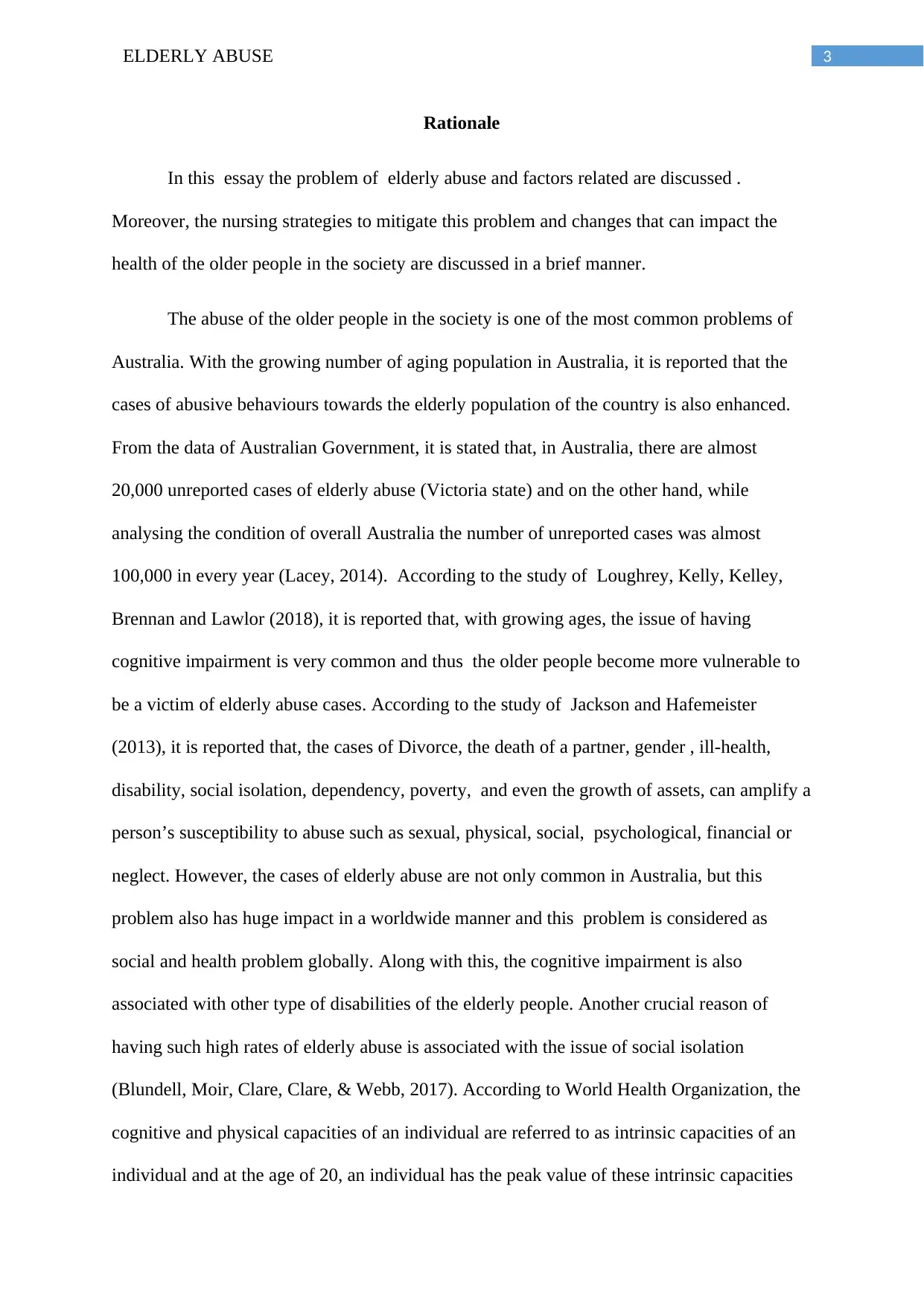
3ELDERLY ABUSE
Rationale
In this essay the problem of elderly abuse and factors related are discussed .
Moreover, the nursing strategies to mitigate this problem and changes that can impact the
health of the older people in the society are discussed in a brief manner.
The abuse of the older people in the society is one of the most common problems of
Australia. With the growing number of aging population in Australia, it is reported that the
cases of abusive behaviours towards the elderly population of the country is also enhanced.
From the data of Australian Government, it is stated that, in Australia, there are almost
20,000 unreported cases of elderly abuse (Victoria state) and on the other hand, while
analysing the condition of overall Australia the number of unreported cases was almost
100,000 in every year (Lacey, 2014). According to the study of Loughrey, Kelly, Kelley,
Brennan and Lawlor (2018), it is reported that, with growing ages, the issue of having
cognitive impairment is very common and thus the older people become more vulnerable to
be a victim of elderly abuse cases. According to the study of Jackson and Hafemeister
(2013), it is reported that, the cases of Divorce, the death of a partner, gender , ill-health,
disability, social isolation, dependency, poverty, and even the growth of assets, can amplify a
person’s susceptibility to abuse such as sexual, physical, social, psychological, financial or
neglect. However, the cases of elderly abuse are not only common in Australia, but this
problem also has huge impact in a worldwide manner and this problem is considered as
social and health problem globally. Along with this, the cognitive impairment is also
associated with other type of disabilities of the elderly people. Another crucial reason of
having such high rates of elderly abuse is associated with the issue of social isolation
(Blundell, Moir, Clare, Clare, & Webb, 2017). According to World Health Organization, the
cognitive and physical capacities of an individual are referred to as intrinsic capacities of an
individual and at the age of 20, an individual has the peak value of these intrinsic capacities
Rationale
In this essay the problem of elderly abuse and factors related are discussed .
Moreover, the nursing strategies to mitigate this problem and changes that can impact the
health of the older people in the society are discussed in a brief manner.
The abuse of the older people in the society is one of the most common problems of
Australia. With the growing number of aging population in Australia, it is reported that the
cases of abusive behaviours towards the elderly population of the country is also enhanced.
From the data of Australian Government, it is stated that, in Australia, there are almost
20,000 unreported cases of elderly abuse (Victoria state) and on the other hand, while
analysing the condition of overall Australia the number of unreported cases was almost
100,000 in every year (Lacey, 2014). According to the study of Loughrey, Kelly, Kelley,
Brennan and Lawlor (2018), it is reported that, with growing ages, the issue of having
cognitive impairment is very common and thus the older people become more vulnerable to
be a victim of elderly abuse cases. According to the study of Jackson and Hafemeister
(2013), it is reported that, the cases of Divorce, the death of a partner, gender , ill-health,
disability, social isolation, dependency, poverty, and even the growth of assets, can amplify a
person’s susceptibility to abuse such as sexual, physical, social, psychological, financial or
neglect. However, the cases of elderly abuse are not only common in Australia, but this
problem also has huge impact in a worldwide manner and this problem is considered as
social and health problem globally. Along with this, the cognitive impairment is also
associated with other type of disabilities of the elderly people. Another crucial reason of
having such high rates of elderly abuse is associated with the issue of social isolation
(Blundell, Moir, Clare, Clare, & Webb, 2017). According to World Health Organization, the
cognitive and physical capacities of an individual are referred to as intrinsic capacities of an
individual and at the age of 20, an individual has the peak value of these intrinsic capacities
Paraphrase This Document
Need a fresh take? Get an instant paraphrase of this document with our AI Paraphraser
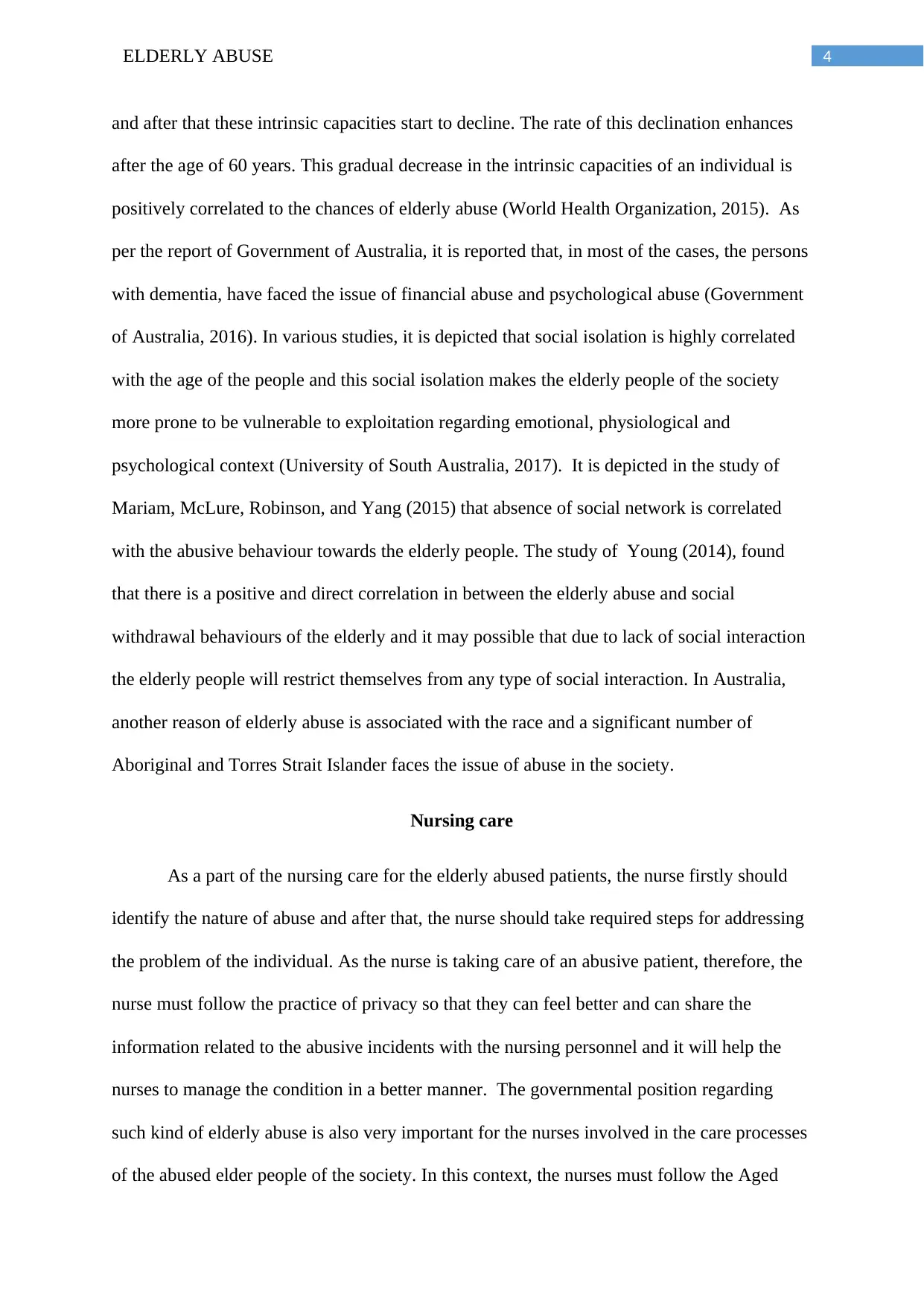
4ELDERLY ABUSE
and after that these intrinsic capacities start to decline. The rate of this declination enhances
after the age of 60 years. This gradual decrease in the intrinsic capacities of an individual is
positively correlated to the chances of elderly abuse (World Health Organization, 2015). As
per the report of Government of Australia, it is reported that, in most of the cases, the persons
with dementia, have faced the issue of financial abuse and psychological abuse (Government
of Australia, 2016). In various studies, it is depicted that social isolation is highly correlated
with the age of the people and this social isolation makes the elderly people of the society
more prone to be vulnerable to exploitation regarding emotional, physiological and
psychological context (University of South Australia, 2017). It is depicted in the study of
Mariam, McLure, Robinson, and Yang (2015) that absence of social network is correlated
with the abusive behaviour towards the elderly people. The study of Young (2014), found
that there is a positive and direct correlation in between the elderly abuse and social
withdrawal behaviours of the elderly and it may possible that due to lack of social interaction
the elderly people will restrict themselves from any type of social interaction. In Australia,
another reason of elderly abuse is associated with the race and a significant number of
Aboriginal and Torres Strait Islander faces the issue of abuse in the society.
Nursing care
As a part of the nursing care for the elderly abused patients, the nurse firstly should
identify the nature of abuse and after that, the nurse should take required steps for addressing
the problem of the individual. As the nurse is taking care of an abusive patient, therefore, the
nurse must follow the practice of privacy so that they can feel better and can share the
information related to the abusive incidents with the nursing personnel and it will help the
nurses to manage the condition in a better manner. The governmental position regarding
such kind of elderly abuse is also very important for the nurses involved in the care processes
of the abused elder people of the society. In this context, the nurses must follow the Aged
and after that these intrinsic capacities start to decline. The rate of this declination enhances
after the age of 60 years. This gradual decrease in the intrinsic capacities of an individual is
positively correlated to the chances of elderly abuse (World Health Organization, 2015). As
per the report of Government of Australia, it is reported that, in most of the cases, the persons
with dementia, have faced the issue of financial abuse and psychological abuse (Government
of Australia, 2016). In various studies, it is depicted that social isolation is highly correlated
with the age of the people and this social isolation makes the elderly people of the society
more prone to be vulnerable to exploitation regarding emotional, physiological and
psychological context (University of South Australia, 2017). It is depicted in the study of
Mariam, McLure, Robinson, and Yang (2015) that absence of social network is correlated
with the abusive behaviour towards the elderly people. The study of Young (2014), found
that there is a positive and direct correlation in between the elderly abuse and social
withdrawal behaviours of the elderly and it may possible that due to lack of social interaction
the elderly people will restrict themselves from any type of social interaction. In Australia,
another reason of elderly abuse is associated with the race and a significant number of
Aboriginal and Torres Strait Islander faces the issue of abuse in the society.
Nursing care
As a part of the nursing care for the elderly abused patients, the nurse firstly should
identify the nature of abuse and after that, the nurse should take required steps for addressing
the problem of the individual. As the nurse is taking care of an abusive patient, therefore, the
nurse must follow the practice of privacy so that they can feel better and can share the
information related to the abusive incidents with the nursing personnel and it will help the
nurses to manage the condition in a better manner. The governmental position regarding
such kind of elderly abuse is also very important for the nurses involved in the care processes
of the abused elder people of the society. In this context, the nurses must follow the Aged
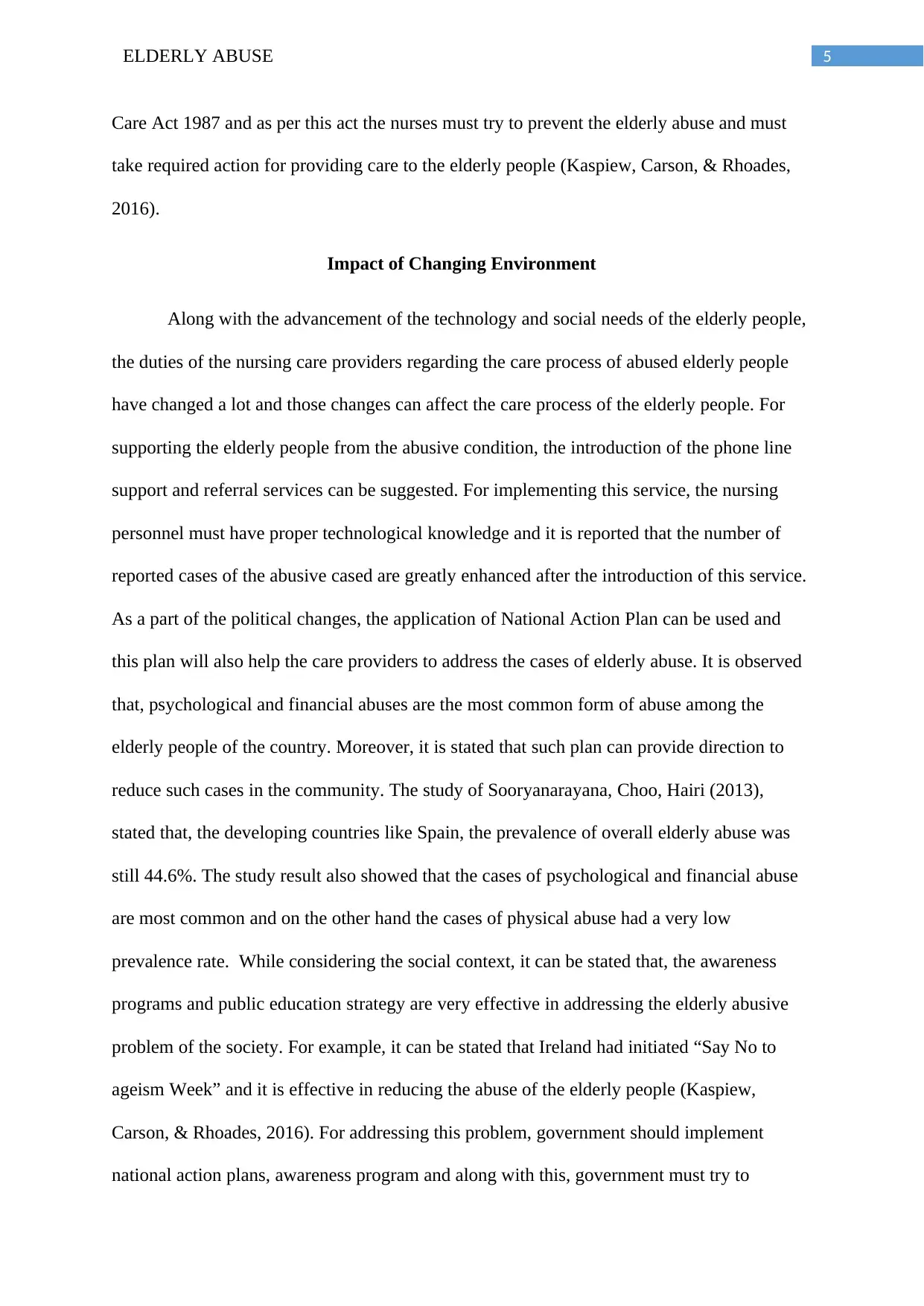
5ELDERLY ABUSE
Care Act 1987 and as per this act the nurses must try to prevent the elderly abuse and must
take required action for providing care to the elderly people (Kaspiew, Carson, & Rhoades,
2016).
Impact of Changing Environment
Along with the advancement of the technology and social needs of the elderly people,
the duties of the nursing care providers regarding the care process of abused elderly people
have changed a lot and those changes can affect the care process of the elderly people. For
supporting the elderly people from the abusive condition, the introduction of the phone line
support and referral services can be suggested. For implementing this service, the nursing
personnel must have proper technological knowledge and it is reported that the number of
reported cases of the abusive cased are greatly enhanced after the introduction of this service.
As a part of the political changes, the application of National Action Plan can be used and
this plan will also help the care providers to address the cases of elderly abuse. It is observed
that, psychological and financial abuses are the most common form of abuse among the
elderly people of the country. Moreover, it is stated that such plan can provide direction to
reduce such cases in the community. The study of Sooryanarayana, Choo, Hairi (2013),
stated that, the developing countries like Spain, the prevalence of overall elderly abuse was
still 44.6%. The study result also showed that the cases of psychological and financial abuse
are most common and on the other hand the cases of physical abuse had a very low
prevalence rate. While considering the social context, it can be stated that, the awareness
programs and public education strategy are very effective in addressing the elderly abusive
problem of the society. For example, it can be stated that Ireland had initiated “Say No to
ageism Week” and it is effective in reducing the abuse of the elderly people (Kaspiew,
Carson, & Rhoades, 2016). For addressing this problem, government should implement
national action plans, awareness program and along with this, government must try to
Care Act 1987 and as per this act the nurses must try to prevent the elderly abuse and must
take required action for providing care to the elderly people (Kaspiew, Carson, & Rhoades,
2016).
Impact of Changing Environment
Along with the advancement of the technology and social needs of the elderly people,
the duties of the nursing care providers regarding the care process of abused elderly people
have changed a lot and those changes can affect the care process of the elderly people. For
supporting the elderly people from the abusive condition, the introduction of the phone line
support and referral services can be suggested. For implementing this service, the nursing
personnel must have proper technological knowledge and it is reported that the number of
reported cases of the abusive cased are greatly enhanced after the introduction of this service.
As a part of the political changes, the application of National Action Plan can be used and
this plan will also help the care providers to address the cases of elderly abuse. It is observed
that, psychological and financial abuses are the most common form of abuse among the
elderly people of the country. Moreover, it is stated that such plan can provide direction to
reduce such cases in the community. The study of Sooryanarayana, Choo, Hairi (2013),
stated that, the developing countries like Spain, the prevalence of overall elderly abuse was
still 44.6%. The study result also showed that the cases of psychological and financial abuse
are most common and on the other hand the cases of physical abuse had a very low
prevalence rate. While considering the social context, it can be stated that, the awareness
programs and public education strategy are very effective in addressing the elderly abusive
problem of the society. For example, it can be stated that Ireland had initiated “Say No to
ageism Week” and it is effective in reducing the abuse of the elderly people (Kaspiew,
Carson, & Rhoades, 2016). For addressing this problem, government should implement
national action plans, awareness program and along with this, government must try to
⊘ This is a preview!⊘
Do you want full access?
Subscribe today to unlock all pages.

Trusted by 1+ million students worldwide
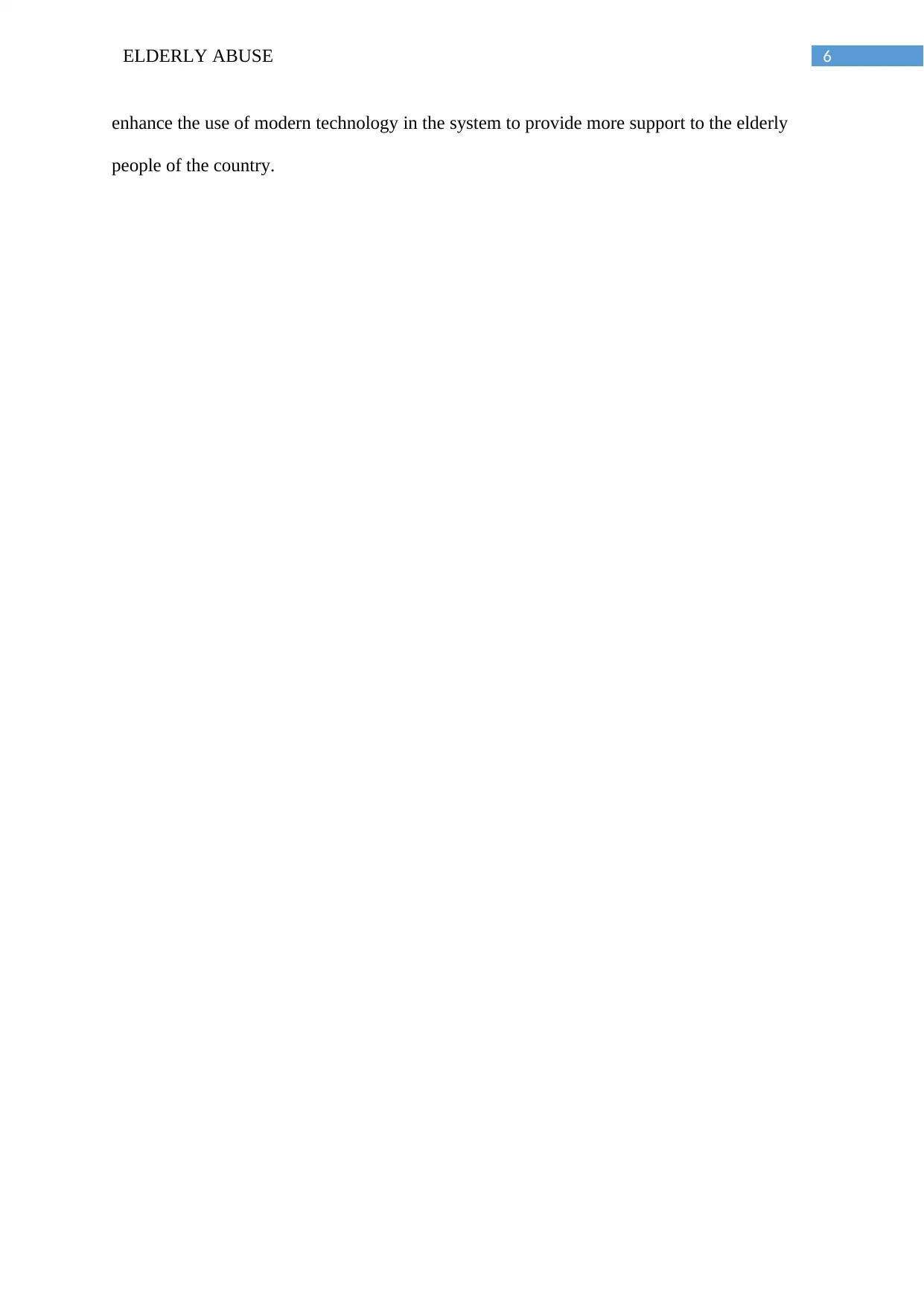
6ELDERLY ABUSE
enhance the use of modern technology in the system to provide more support to the elderly
people of the country.
enhance the use of modern technology in the system to provide more support to the elderly
people of the country.
Paraphrase This Document
Need a fresh take? Get an instant paraphrase of this document with our AI Paraphraser
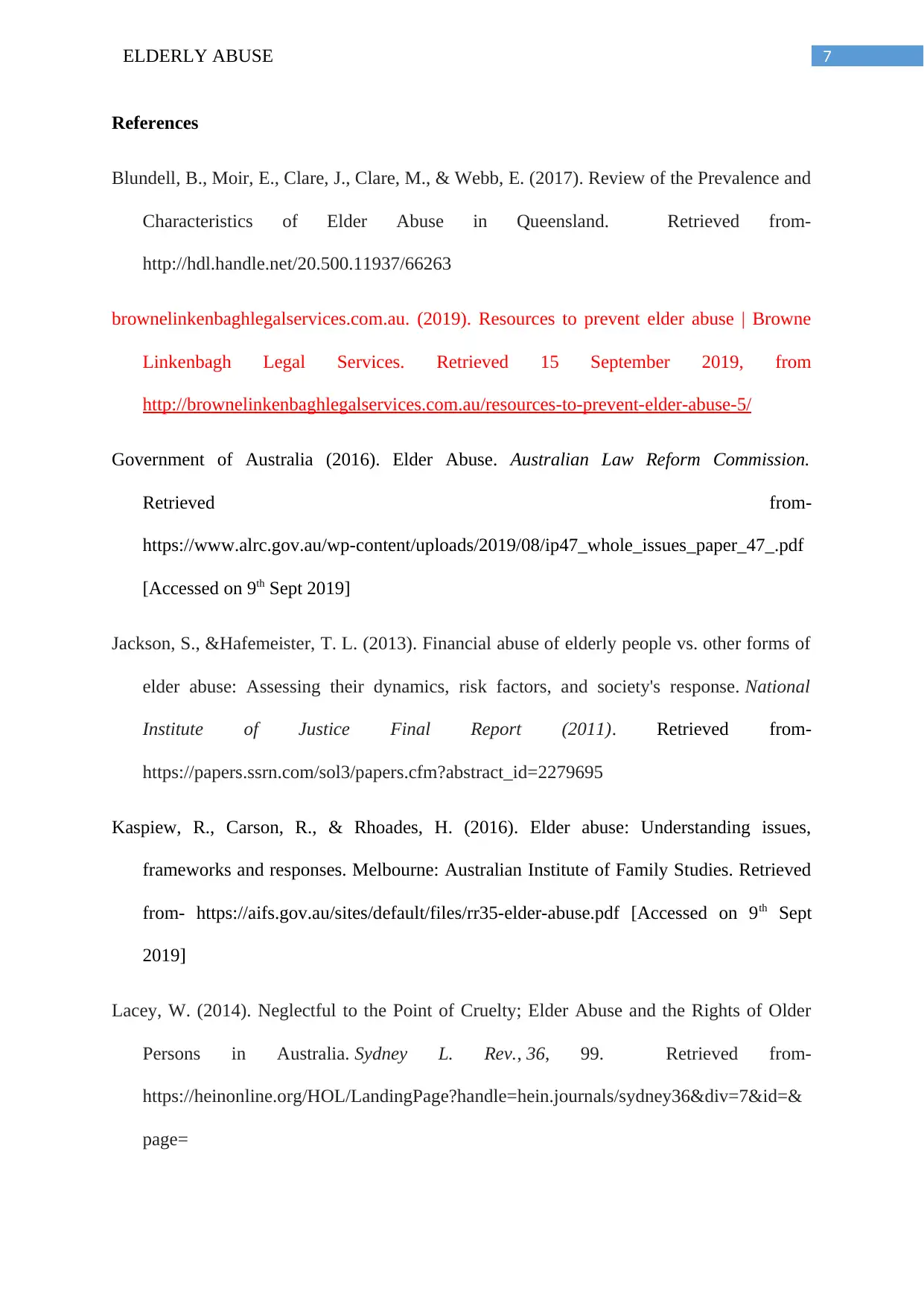
7ELDERLY ABUSE
References
Blundell, B., Moir, E., Clare, J., Clare, M., & Webb, E. (2017). Review of the Prevalence and
Characteristics of Elder Abuse in Queensland. Retrieved from-
http://hdl.handle.net/20.500.11937/66263
brownelinkenbaghlegalservices.com.au. (2019). Resources to prevent elder abuse | Browne
Linkenbagh Legal Services. Retrieved 15 September 2019, from
http://brownelinkenbaghlegalservices.com.au/resources-to-prevent-elder-abuse-5/
Government of Australia (2016). Elder Abuse. Australian Law Reform Commission.
Retrieved from-
https://www.alrc.gov.au/wp-content/uploads/2019/08/ip47_whole_issues_paper_47_.pdf
[Accessed on 9th Sept 2019]
Jackson, S., &Hafemeister, T. L. (2013). Financial abuse of elderly people vs. other forms of
elder abuse: Assessing their dynamics, risk factors, and society's response. National
Institute of Justice Final Report (2011). Retrieved from-
https://papers.ssrn.com/sol3/papers.cfm?abstract_id=2279695
Kaspiew, R., Carson, R., & Rhoades, H. (2016). Elder abuse: Understanding issues,
frameworks and responses. Melbourne: Australian Institute of Family Studies. Retrieved
from- https://aifs.gov.au/sites/default/files/rr35-elder-abuse.pdf [Accessed on 9th Sept
2019]
Lacey, W. (2014). Neglectful to the Point of Cruelty; Elder Abuse and the Rights of Older
Persons in Australia. Sydney L. Rev., 36, 99. Retrieved from-
https://heinonline.org/HOL/LandingPage?handle=hein.journals/sydney36&div=7&id=&
page=
References
Blundell, B., Moir, E., Clare, J., Clare, M., & Webb, E. (2017). Review of the Prevalence and
Characteristics of Elder Abuse in Queensland. Retrieved from-
http://hdl.handle.net/20.500.11937/66263
brownelinkenbaghlegalservices.com.au. (2019). Resources to prevent elder abuse | Browne
Linkenbagh Legal Services. Retrieved 15 September 2019, from
http://brownelinkenbaghlegalservices.com.au/resources-to-prevent-elder-abuse-5/
Government of Australia (2016). Elder Abuse. Australian Law Reform Commission.
Retrieved from-
https://www.alrc.gov.au/wp-content/uploads/2019/08/ip47_whole_issues_paper_47_.pdf
[Accessed on 9th Sept 2019]
Jackson, S., &Hafemeister, T. L. (2013). Financial abuse of elderly people vs. other forms of
elder abuse: Assessing their dynamics, risk factors, and society's response. National
Institute of Justice Final Report (2011). Retrieved from-
https://papers.ssrn.com/sol3/papers.cfm?abstract_id=2279695
Kaspiew, R., Carson, R., & Rhoades, H. (2016). Elder abuse: Understanding issues,
frameworks and responses. Melbourne: Australian Institute of Family Studies. Retrieved
from- https://aifs.gov.au/sites/default/files/rr35-elder-abuse.pdf [Accessed on 9th Sept
2019]
Lacey, W. (2014). Neglectful to the Point of Cruelty; Elder Abuse and the Rights of Older
Persons in Australia. Sydney L. Rev., 36, 99. Retrieved from-
https://heinonline.org/HOL/LandingPage?handle=hein.journals/sydney36&div=7&id=&
page=
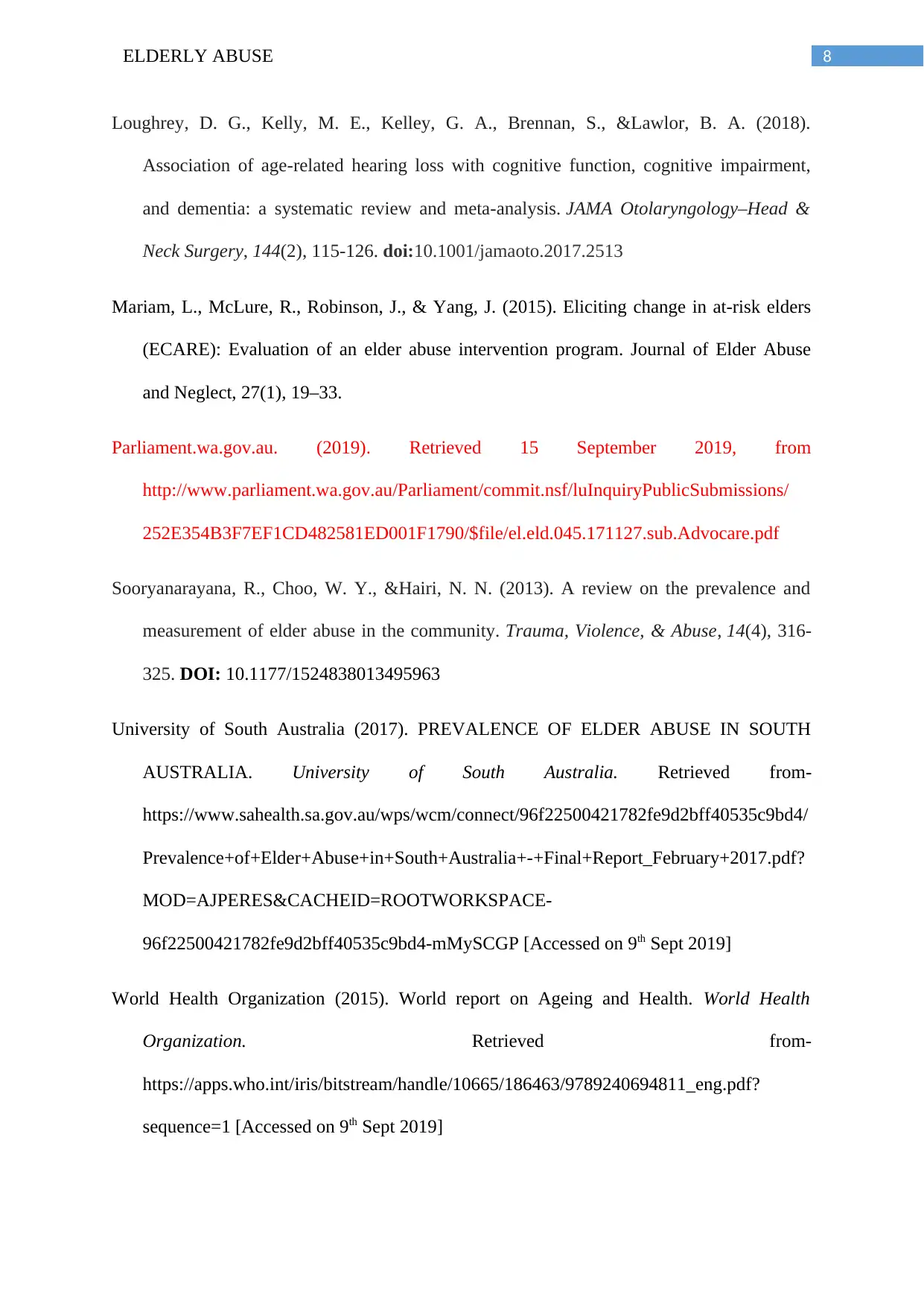
8ELDERLY ABUSE
Loughrey, D. G., Kelly, M. E., Kelley, G. A., Brennan, S., &Lawlor, B. A. (2018).
Association of age-related hearing loss with cognitive function, cognitive impairment,
and dementia: a systematic review and meta-analysis. JAMA Otolaryngology–Head &
Neck Surgery, 144(2), 115-126. doi:10.1001/jamaoto.2017.2513
Mariam, L., McLure, R., Robinson, J., & Yang, J. (2015). Eliciting change in at-risk elders
(ECARE): Evaluation of an elder abuse intervention program. Journal of Elder Abuse
and Neglect, 27(1), 19–33.
Parliament.wa.gov.au. (2019). Retrieved 15 September 2019, from
http://www.parliament.wa.gov.au/Parliament/commit.nsf/luInquiryPublicSubmissions/
252E354B3F7EF1CD482581ED001F1790/$file/el.eld.045.171127.sub.Advocare.pdf
Sooryanarayana, R., Choo, W. Y., &Hairi, N. N. (2013). A review on the prevalence and
measurement of elder abuse in the community. Trauma, Violence, & Abuse, 14(4), 316-
325. DOI: 10.1177/1524838013495963
University of South Australia (2017). PREVALENCE OF ELDER ABUSE IN SOUTH
AUSTRALIA. University of South Australia. Retrieved from-
https://www.sahealth.sa.gov.au/wps/wcm/connect/96f22500421782fe9d2bff40535c9bd4/
Prevalence+of+Elder+Abuse+in+South+Australia+-+Final+Report_February+2017.pdf?
MOD=AJPERES&CACHEID=ROOTWORKSPACE-
96f22500421782fe9d2bff40535c9bd4-mMySCGP [Accessed on 9th Sept 2019]
World Health Organization (2015). World report on Ageing and Health. World Health
Organization. Retrieved from-
https://apps.who.int/iris/bitstream/handle/10665/186463/9789240694811_eng.pdf?
sequence=1 [Accessed on 9th Sept 2019]
Loughrey, D. G., Kelly, M. E., Kelley, G. A., Brennan, S., &Lawlor, B. A. (2018).
Association of age-related hearing loss with cognitive function, cognitive impairment,
and dementia: a systematic review and meta-analysis. JAMA Otolaryngology–Head &
Neck Surgery, 144(2), 115-126. doi:10.1001/jamaoto.2017.2513
Mariam, L., McLure, R., Robinson, J., & Yang, J. (2015). Eliciting change in at-risk elders
(ECARE): Evaluation of an elder abuse intervention program. Journal of Elder Abuse
and Neglect, 27(1), 19–33.
Parliament.wa.gov.au. (2019). Retrieved 15 September 2019, from
http://www.parliament.wa.gov.au/Parliament/commit.nsf/luInquiryPublicSubmissions/
252E354B3F7EF1CD482581ED001F1790/$file/el.eld.045.171127.sub.Advocare.pdf
Sooryanarayana, R., Choo, W. Y., &Hairi, N. N. (2013). A review on the prevalence and
measurement of elder abuse in the community. Trauma, Violence, & Abuse, 14(4), 316-
325. DOI: 10.1177/1524838013495963
University of South Australia (2017). PREVALENCE OF ELDER ABUSE IN SOUTH
AUSTRALIA. University of South Australia. Retrieved from-
https://www.sahealth.sa.gov.au/wps/wcm/connect/96f22500421782fe9d2bff40535c9bd4/
Prevalence+of+Elder+Abuse+in+South+Australia+-+Final+Report_February+2017.pdf?
MOD=AJPERES&CACHEID=ROOTWORKSPACE-
96f22500421782fe9d2bff40535c9bd4-mMySCGP [Accessed on 9th Sept 2019]
World Health Organization (2015). World report on Ageing and Health. World Health
Organization. Retrieved from-
https://apps.who.int/iris/bitstream/handle/10665/186463/9789240694811_eng.pdf?
sequence=1 [Accessed on 9th Sept 2019]
⊘ This is a preview!⊘
Do you want full access?
Subscribe today to unlock all pages.

Trusted by 1+ million students worldwide
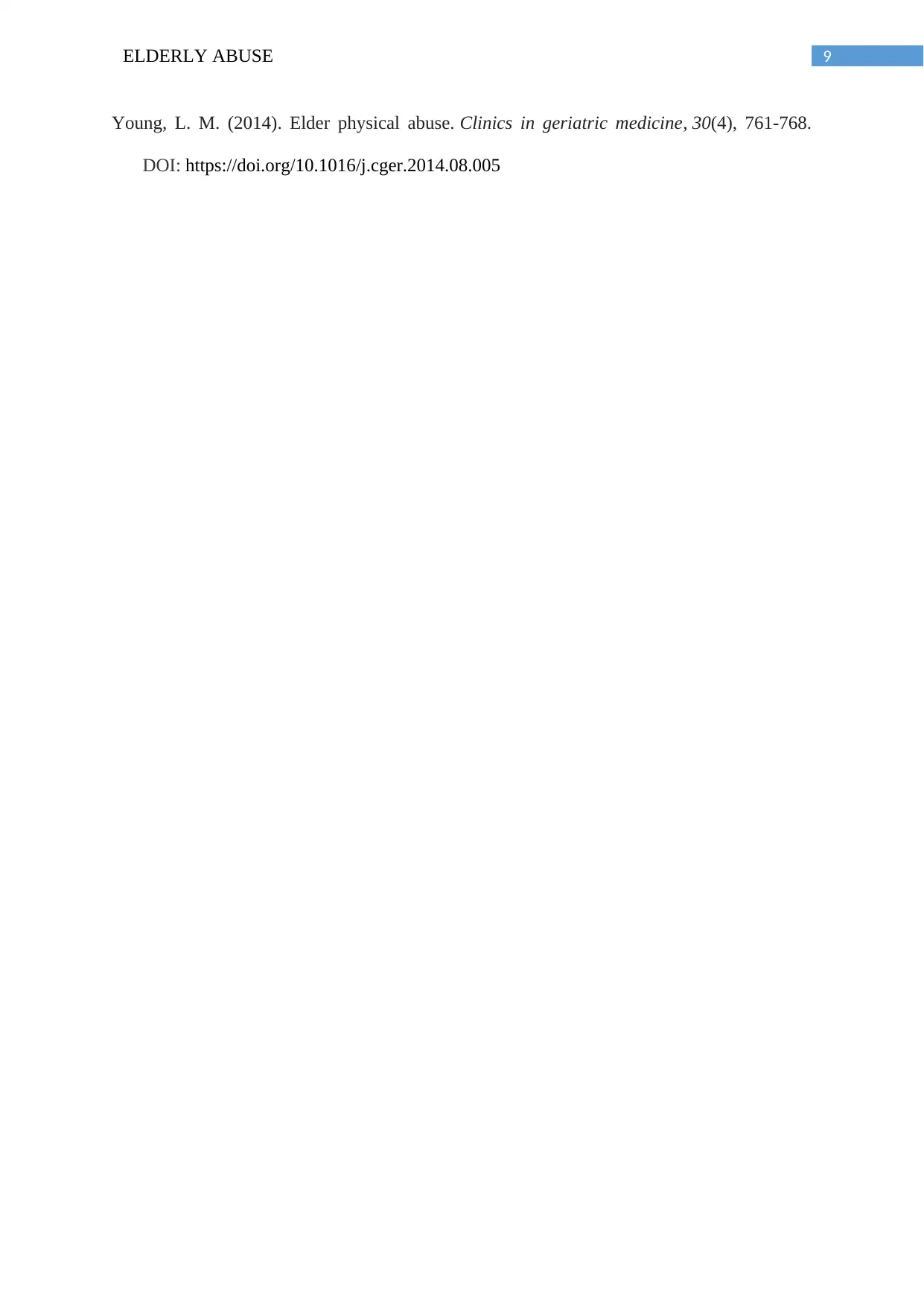
9ELDERLY ABUSE
Young, L. M. (2014). Elder physical abuse. Clinics in geriatric medicine, 30(4), 761-768.
DOI: https://doi.org/10.1016/j.cger.2014.08.005
Young, L. M. (2014). Elder physical abuse. Clinics in geriatric medicine, 30(4), 761-768.
DOI: https://doi.org/10.1016/j.cger.2014.08.005
1 out of 10
Related Documents
Your All-in-One AI-Powered Toolkit for Academic Success.
+13062052269
info@desklib.com
Available 24*7 on WhatsApp / Email
![[object Object]](/_next/static/media/star-bottom.7253800d.svg)
Unlock your academic potential
Copyright © 2020–2025 A2Z Services. All Rights Reserved. Developed and managed by ZUCOL.





